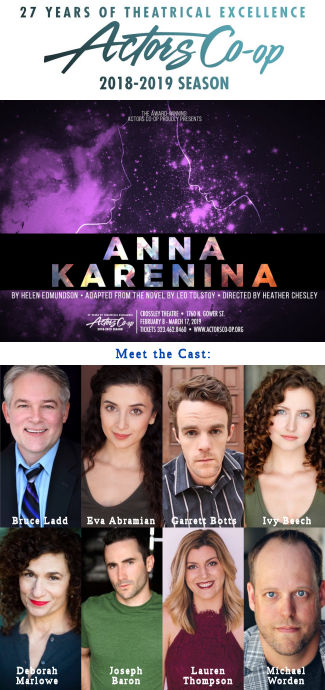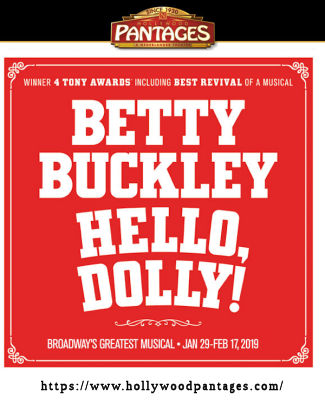
 C’mon, do you really expect something involving Russians, affairs, and political leaders to have a happy ending? Has the 2016 election taught you nothing?
C’mon, do you really expect something involving Russians, affairs, and political leaders to have a happy ending? Has the 2016 election taught you nothing?
But seriously, last weekend was a weekend of theatrical whiplash, going from the positive uplifting message of the musical 1776 to the sturm und drang-ish drama of the play Anna Karenina, adapted from the Leo Tolstoy novel by Helen Edmundson in 1992 and currently on-stage at Actors Co-op (FB) through March 17, 2019.
Anna Karenina is a classic of Russian literature, and (at least according to Wikipedia), some consider it the greatest novel ever written. I think that’s Russian propaganda. You can read the full gory synopsis on the Wikipedia page; here’s a 50,000 ft. view of the novel (also from the Wikipedia page):
Anna Karenina is the tragic story of Countess Anna Karenina, a married noblewoman and socialite, and her affair with the affluent Count Vronsky. The story starts when she arrives in the midst of a family broken up by her brother’s unbridled womanizing—something that prefigures her own later situation, though she would experience less tolerance by others. A bachelor, Vronsky is eager to marry Anna if she will agree to leave her husband Count Karenin, a senior government official, but she is vulnerable to the pressures of Russian social norms, the moral laws of the Russian Orthodox Church, her own insecurities, and Karenin’s indecision. Although Vronsky and Anna go to Italy, where they can be together, they have trouble making friends. Back in Russia, she is shunned, becoming further isolated and anxious, while Vronsky pursues his social life. Despite Vronsky’s reassurances, she grows increasingly possessive and paranoid about his imagined infidelity, fearing loss of control. A parallel story within the novel is that of Konstantin Lëvin or Ljovin, a wealthy country landowner who wants to marry Princess Kitty, sister to Princess Dolly and sister-in-law to Anna’s brother Prince Oblonsky. Konstantin has to propose twice before Kitty accepts. The novel details Konstantin’s difficulties managing his estate, his eventual marriage, and his struggle to accept the Christian faith, until the birth of his first child.
Edmundson’s adaptation (and director Heather Chesley (FB)’s staging and Stephen Gifford (FB)’s scenic design) makes this all much more abstract. You start with Anna and Constantine “Kostya” on a bare stage with four chairs, as if in an afterlife, haunted by ghosts of some sort. They are constantly asking where they are now, which is seemingly an expositional technique to establish place and allow them to introduce their separate parts of the story. They don’t meet in “real life” until somewhere late in the second act. Around them we see the action unfold with the other characters, with actors often playing multiple roles in the different threads of the stories. Yes, it does end with the suicide in the train station (c’mon, it’s a classic novel and a classic trope, so it shouldn’t be a spoiler), but it is all done very abstractly.
For me — and I’ll emphasize that this is my opinion — the story just didn’t grab me. I really can’t get into a complex tale of infidelity, shifting affairs, Russian societal position, and a fair amount of depression and lack of self worth. It just wasn’t my thing, but I’ll emphasize that’s why we subscribe to theatres: it brings us to shows we might not normally seek out on our own. But that also brings the risk that we might not like everything we see.
But just because I didn’t get into the story doesn’t mean I didn’t like the performances. Chesley brought out great performances in her acting team, and they were believable as their characters. This is especially true for the two leads: Eva Abramian (FB) as Anna Karenina and Joseph Barone (FB) as Constantine “Kostya” Levin. The two had good chemistry together and were fun to watch.
All of the other characters played both a “major” and a minor role, which makes it difficult to tier or group them. But I’ll try. We’ll start with Anna’s brother, Stiva, played by Michael Worden (FB) [also: Vassily the Bailiff, Petristsky, the Priest] and his wife, Dolly, played by Lauren Thompson(FB) [also: Countess Vronsky]. Worden’s Stiva came across as a “bro” in modern speak: a man interested in womanizing and fun more than his family. In this, Worden portrayed him well. Thompson’s Dolly was more the dutiful wife, staying with a man she didn’t like for the sake of the marriage. Again, a strong portrayal.
Moving to Anna’s lovers, we have Bruce Ladd (FB) as Alexei Alexandrovich Karenin, her husband, and Garrett Botts (FB) as Count Alexei Vronsky, her lover [also: Nikolai]. I liked Ladd’s performance, but I’ve liked him ever since seeing him in A Man for All Seasons last year. He’s a great actor, and fun to watch. Botts was believable as the Russian Captain who was obsessed with Anna, after being obsessed with Kitty, after …. It was an interesting love triangle.
This brings us to Kostya’s object of affection: Kitty, played by Ivy Beech (FB) [also: Seriozha]. As Kitty, she was strong and believable in her emotional arc. As Seriozha, she was less believable, but that was primarily an age problem.
Lastly, there was the exceptional character actor in the Co-Op stable: Deborah Marlowe (FB), this time as Princess Betsy / Agatha / Governess / Railway Widow. Marlowe specializes in these small character roles, and always does them well.
There is one understudy listed in the program: Micah Kobayashi [u/s for Princess Betsy / Agatha / Governess / Railway Widow].
As noted earlier, Stephen Gifford (FB)’s scenic design was simple and abstract, supplemented by Lori Berg (FB)’s property design. This was supported by Vicki Conrad (FB)’s costume, hair, and makeup, which seemed, suitably, Russian and period. David B. Marling (FB)’s sound design provided good sound effects. Lisa D. Katz (FB)’s lighting established the place and mood well. Other production credits: Nora Feldman [Publicist]; Julie Hall (FB) [Choreography]; Selah Victor (FB) [Production Manager]; Eric M. White (FB) [Stage Manager]; and Kay Bess (FB) [Producer].
Anna Karenina continues at Actors Co-op (FB) through March 17, 2019. It wasn’t my favorite story, but the performances are strong. If it is a story you’re into, then you’ll likely enjoy this production. Tickets are available through the Actors Co-Op Website. Discount tickets may be available on Goldstar.
***
Ob. Disclaimer: I am not a trained theatre (or music) critic; I am, however, a regular theatre and music audience member. I’ve been attending live theatre and concerts in Los Angeles since 1972; I’ve been writing up my thoughts on theatre (and the shows I see) since 2004. I do not have theatre training (I’m a computer security specialist), but have learned a lot about theatre over my many years of attending theatre and talking to talented professionals. I pay for all my tickets unless otherwise noted (or I’ll make a donation to the theatre, in lieu of payment). I am not compensated by anyone for doing these writeups in any way, shape, or form. I currently subscribe at 5 Star Theatricals (FB), the Hollywood Pantages (FB), Actors Co-op (FB), and the Ahmanson Theatre (FB). Through my theatre attendance I have made friends with cast, crew, and producers, but I do strive to not let those relationships color my writing (with one exception: when writing up children’s production, I focus on the positive — one gains nothing except bad karma by raking a child over the coals). I believe in telling you about the shows I see to help you form your opinion; it is up to you to determine the weight you give my writeups.
Upcoming Shows:
Presidents Day weekend brings The Joy Wheel at Ruskin Group Theatre (FB) in Santa Monica. The last weekend of February is our annual trek to the Anaheim Hills for Lizzie at the Chance Theatre (FB).
March starts with Matthew Bourne’s Cinderella at the Ahmanson Theatre (FB), followed by the annual MRJ Regional Man of the Year dinner at Temple Beth Hillel. The next weekend brings “Disney’s Silly Symphony” at the Saroya [nee the Valley Performing Arts Center (VPAC)] (FB). The third weekend of March brings Cats at the Hollywood Pantages (FB). The following weekend is Matilda at 5 Star Theatricals (FB) on Saturday, followed by Ada and the Engine at Theatre Unleashed (FB) (studio/stage) on Sunday. March concludes with us back at the Hollywood Pantages (FB) for Charlie and the Chocolate Factory.
Lastly, looking into April: The month starts with Steel Magnolias at Actors Co-op (FB) and the MoTAS Men’s Seder. The next weekend has a hold for OERM. April will also bring Fiddler on the Roof at the Hollywood Pantages (FB) and the annual visit to the Renaissance Pleasure Faire.
As always, I’m keeping my eyes open for interesting productions mentioned on sites such as Better-Lemons, Musicals in LA, @ This Stage, Footlights, as well as productions I see on Goldstar, LA Stage Tix, Plays411 or that are sent to me by publicists or the venues themselves. Note: Lastly, want to know how to attend lots of live stuff affordably? Take a look at my post on How to attend Live Theatre on a Budget.



 There are those that would have you believe that the founders of our nation were perfect and infallible, working with a God-given drive to create America. Those folks would make you believe that their decisions were right then, and are right for now. Those folks … would be wrong.
There are those that would have you believe that the founders of our nation were perfect and infallible, working with a God-given drive to create America. Those folks would make you believe that their decisions were right then, and are right for now. Those folks … would be wrong.
 If you’re like me, you always thought you had seen Hello, Dolly!. Sure, you listened to the cast album zillions of times. Sure, you’ve seen
If you’re like me, you always thought you had seen Hello, Dolly!. Sure, you listened to the cast album zillions of times. Sure, you’ve seen  The shows announced are as follows:
The shows announced are as follows: